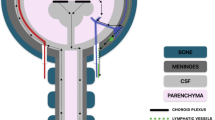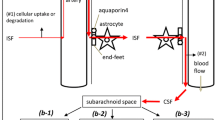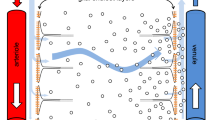Summary
The feline infusion model of brain edema was used to evaluate the pathophysiological effects of 0.6ml infusions of autologous serum protein (66%), human serum protein (66%), human glioma cyst fluid and a tissue culture medium (TCM) on the structure and function of the forebrain white matter. These infusions increased local white matter water content by between 10.8 and 12.5 ml/100 g brain and were associated with moderate increases in ICP and CSF outflow resistance and a significant decrease in lumped craniospinal compliance. Cortical somatosensory potentials, motor evoked potentials, EEG and local cerebral blood flow (rCBF) at normocapnia were generally unchanged by the various infusions. All infusates except the 66% autologous serum protein infusion impaired rCBF CO2 reactivity. Histologically all infusates caused marked extracellular edema. The autologous serum protein infusion caused no additional histological changes whereas the glioma cyst infusates caused profound endothelial and astrocytic swelling, focal endothelial necrosis, basement membrane disruption, perivascular microglial reaction and pavementation and perivascular migration of polymor-phonuclear leukocytes. Similar but less marked changes were seen after infusion of human serum protein whilst the TCM produced only minimal changes. The intensity and extent of Evans Blue extravasation into the forebrain white matter was greatest with glioma cyst infusates and with all infusions reflected the extent to microvascular changes.
These studies show that products derived from gliomas cause additional damage to the blood-brain-barrier than that caused by non-autologous serum proteins. These results add further support for the existence of glioma derived permeability factors (GDPF), but suggest neither serum proteins nor glioma derived compounds in the white matter interstitium significantly influence local electrophysiological function. Some limitations of the infusion edema model when using non-autologous infusions and difficulties quantitating brain dysfunction are emphasised.
Similar content being viewed by others
References
Arenander AT, Vellis J de (1980) Glial-released proteins in clonal cultures and their modification by hydrocortisone. Brain Res 200: 401–409
Bell BA, Smith MA, Tocher JLet al (1987) Correction factors for gravimetric measurement of peritumoural oedema in man. Brit J Neurosurg 1: 441–446
Black KL, King WA, Ikezaki K (1990) Selectie opening of the blood-tumour brain by intracarotid infusion of leukotriene C4. J Neurosurg 72: 912–916
Bodsch W, Rommel T, Ophoff BGet al (1987) Factors responsible for the retention of fluid in human tumor edema and the effect of dexamethasone. J Neurosurg 67: 250–257
Bothe H WW, Bodsch W, Hossmann KA (1984) Relationship between specific gravity, water content and serum protein extravasation in various types of vasogenic brain edema. Acta Neuropath (Berl) 64: 37–42
Branston N M, Symom L, Crockard H Aet al (1974) Relationship between cortical evoked potential and local blood flow following acute middle cerebral artery occlusion in the baboon. Exp Neurol 45: 195–208
Brett M, Weller RO (1978) Intracellular serum proteins in cerebral gliomas and metastatic tumours; an immunoperoxidase study. Neuropath Appl Neurobiol 4: 263–272
Britt RH, Enzmann DR, Yeager AS (1981) Neuropathological and computerized tomographic findings in experimental brain abscess. J Neurosurg 55: 590–603
Bruce JN, Criscuolo GR, Merrill MJet al (1987) Vascular permeability induced by protein product of malignant brain tumours; inhibition by dexamethasone. J Neurosurg 67: 880–884
Cricuolo GR, Merrill MT, Oldfield EH (1988) Further characterization of malignant glioma derived vascular permeability factor. J Neurosurg 69: 254–262
Del Maestro RF, Megyesi JF, Farrell CL (1990) Mechanisms of tumour associated edema: a review. Canad J Neurol Sci 17: 177–183
Dolman CL (1991) Microglia. In: Davis RL, Robertson DM (eds) Textbook of Neuropathology, 2nd Ed. Williams and Wilkins, Baltimore, pp 141–163
Dong WK, Harkins SW, Ashleman BT (1982) Origin of cat somatosensory farfield and early nearfield evoked potentials. Electroenceph Clin Neurophysiol 53: 143–165
Ebner A, Einsiedel-Lechtape H, Luking CH (1982) Somatosensory tibial nerve evoked potentials with parasagital tumours; a contribution of the problem of generators. Electroencephal Clin Neurophysiol 54: 508–515
Edvinsson L, Cervos-Navarro J, Larsson L Iet al (1977) Regional distribution of mast cells containing histamine, dopamine, or 5-hydroxytryptamine in the mammalian brain. Neurology 27: 878–883
Frei HJ, Wallenfeld T, Poll W (1973) Regional cerebral blood flow and regional metabolism in cold induced edema. Acta Neurochir (Wien) 29: 15–28
Galicich JH, French LA, Melby JC (1961) Use of dexamethasone in the treatment of cerebral edema associated with brain tumours. Lancet 81: 46–51
Gamache DA, Povlishock JT, Ellis EF (1986) Carrageenan induced brain inflammation. J Neurosurg 65: 679–685
Greenfield JG (1939) The histology of cerebral oedema associated with intracranial tumours. Brain 62: 129–152
Haghighi S, Oro JJ (1989) Effects of hypovolemic hypotensive shock on the somatosensory and motor evoked potentials. Neurosurgery 24: 246–252
Hatashita S, Hoff JT (1988) Biomechanics of brain edema in acute cerebral ischemia in the cat. Stroke 19: 91–97
Hino A, Imahori Y, Tenjin Het al (1990) Metabolic and hemodynamic aspects of peritumoural low density areas in human brain tumour. Neurosurgery 26: 615–621
Hossmann KA, Bloink M, Wilmes Fet al (1980) Experimental peritumoural edema of cat brain. Adv Neurology 28: 323–340
Hossmann KA, Hurter T, Oschlies U (1983) The effect of dexamethasone on serum protein extravasation and edema development in experimental brain tumours in the cat. Acta Neuropath (Berl) 60: 223–231
Huston JP, Holzhauer MS (1988) Behaviour and electrophysiological effects of intracerbrally applied neuropeptides with special attention to DC slow wave potential changes. Ann NY Acad Sci 525: 375–391
Ibrahim MZM (1974) The mast cells of the mammalian nervous system. Part 1. Morphology, distribution and histochemistry. J Neurol Sci 21: 431–478
Katoaka K, Graf R, Rosner Get al (1987) Experimental focial ischemia in cats; changes in multimodality evoked potentials as releated to local cerebral blood flow and ischemic brain edema. Stroke 18: 188–194
Lammertsma A, Wise RJ, Cox TCet al (1985) Measurement of blood flow, oxygen utilisation, oxygen extraction ratio and fractional blood volume in human brain tumours and surrounding oedematous tissue. Brit J Radiol 58: 725–734
Lauritzen M (1984) Long lasting reduction of cortical blood flow in the rat brain after spreading depression and impaired CO2 response. J Cereb Blood Flow Metab 4: 546–554
Leenders KL, Beaney RP, Brooks DJet al (1985) Dexamethasone treatment of brain tumour patients; effects on blood flow, blood volume and oxygen utilisation. Neurology 35: 1610–1615
Levy WJ, McCaffrey M, York DMet al (1984) Motor evoked potentials from transcranial stimulation of the motor coretex in cats. Neurosurgery 15: 214–227
Lohle PNM, Verhagen IT, Teelken AWet al (1992) The pathogenesis of cerebral gliomatous cysts. Neurosurgery 30: 180–185
Marmarou A, Shulman K, LaMorgese J (1975) Compartmental analysis of compliance and outflow resistance of the cerebrospinal fluid system. J Neurosurg 48: 523–534
Marmarou A, Takagi H, Shulman K (1980) Biomechanics of brain edema and effects on local blood flow. Adv Neurol 28: 345–358
Marmarou A, Tanaka K, Shulman K (1982) An improved gravimetric measure of cerebral edema. J Neurosurg 56: 246–263
Mosmans PCM (1974) Regional cerebral blood flow in neurological patients. Van Gorcum, Assen, Netherlands, pp 62–71
Nakagawa H, Groothuis D, Owens ESet al (1987) Dexamethasone effect in [125I]albumm distribution in experimental RG-2 gliomas and adjacent brain. J Cereb Blood Flow Metab 7: 687–701
Oettinger W, Baethmann A, Rothenfusser Wet al (1976) Tissue and plasma factors in cerebral edema. In: Pappius HM, Feindel W (eds) Dynamics of brain edema. Springer, Berlin Heidelberg New York, 161–163
Ohata K, Tanaka K, Katsuyama Jet al (1990). Electron microscopic study of perivascular structure associated with experimentally induced brain edema in the bat. Adv Neurol 52: 237–246
Ohnishi T, Sher PB, Posner JBet al (1990) Capillary permeability factor secreted by malignant brain tumour. J Neurosurg 72: 245–251
Ohnishi T, Sher PB, Posner JBet al (1991) Increased capillary permeability in rat brain induced by factors secreted by cultured C6 glioma cells: role in peritumoural edema. J Neurooncol 10: 13–25
Palvolgyi R (1969) Regional cerebral blood flow in patients with intracranial tumours. J Neurosurg 31: 149–163
Pasztor E, Symon L, Dorsch Net al (1973) The hydrogen clearance method in assessment of blood flow in cortex, white matter and deep nuclei of baboons. Stroke 4: 556–563
Penn RD (1980) Cerebral edema and neurological function in human beings. Neurosurgery 6: 249–254
Pilkington G (1989) Steroids and gliomas: experimental and in vitro studies. In: Capildeo R (ed) Steroids in diseases of the nervous system. Wiley, Bristol, pp 83–97
Poliakova AG (1972) Origin of early component of the evoked response in the association cortex of the cat. Electroencephal Clin Neurophysiol 32: 129–138
Quindlen EA, Bucher AE (1987) Correlation of tumour plasminogen activator with peritumoural cerebral edema. J Neurosurg 66: 729–733
Regoli D, Barabe J (1980) The pharmacology of bradykinin and related kinins. Pharm Rev 32: 1–47
Seitz RJ, Wechsler W (1987) Immunohistochemical demonstration of serum proteins in human cerebral gliomas. Acta Neuropathol (Berl) 73: 145–152
Shapiro WR, Hiesiger EM, Cooney GAet al (1990) Temporal effects of dexamethasone on blood brain barrier and blood to tumour transport of14C-alpha-aminoisobutyric acid in rat C6 glioma. J Neurooncol 8: 197–204
Sutton LN, Barranco D, Greenberg Jet al (1989) Cerebral blood flow and glucose metabolism in experimental brain edema. J Neurosurg 71: 868–874
Sutton LN, Bruce DA, Welsh FA, Jaggi JL (1980) Metabolic and electrophysiological consequences of vasogenic brain edema. Adv Neurol 28: 241–254
Sutton LN, Frewen T, Marsh R, Jaggi J, Bruce DA (1982) The effects of deep barbiturate coma on multimodality evoked potentials. J Neurosurg 57: 178–185
Stewart PA, Hayakawa K, Farrell CIet al (1987) Quantitative study of microvessel ultrastructure in human peritumoural brain tissue. J Neurosurg 67: 697–705
Szymas J, Hossman KA (1984) Immunofluorescent investigation of extravasated serum proteins in human brain tumour and adjacent structures. Acta Neurochir (Wien) 71: 229–241
Unterberg A, Baethmann A (1984) The kallikrein-kinin system as a mediator in vasogenic brain edema, Part 1: cerebral exposure to bradykinin and plasma. J Neurosurg 61: 87–96
Unterberg A, Schmidt W, Wahl Met al (1991) Evidence against leukotrienes as mediators of brain edema. J Neurosurg 74: 773–780
Wahl M, Lauritzen M, Schilling L (1987) Change of cerebrovascular reactivity after cortical spreading depression in cats and rats. Brain Res 411: 72–80
Wahl M, Unterberg A, Baethmann A (1988) Mediators of blood brain barrier dysfunction and formation of vasogenic brain oedema. J Cereb Blood Flow Metab 8: 621–634
Whittle IR, Besser M, Johnstone IH (1987) Short latency somatosensory evoked potentials in children. Part 4: findings with cerebral lesions. Surg Neurol 27: 37–43
Whittle IR, Clarke M, Gregori Aet al (1992) Interstitial white matter brain edema does not alter the electroencephalogram. Brit J Neurosurg 6: 429–434
Whittle IR, Piper IR, Miller JD (1991) The contribution of arachidonic acid to the etiology and pathophysiology of vasogenic brain edema: studies using an infusion model. Acta Neurochir (Wien) 113: 57–68
Whittle IR, Piper IR, Miller JD (1992) The role of bradykinin in brain edema formation and perilesional brain dysfunction. Acta Neurochir (Wien) 115: 53–59
Author information
Authors and Affiliations
Rights and permissions
About this article
Cite this article
Whittle, I.R., Ironside, J.W., Piper, I.R. et al. Neuropathological and neurophysiological effects of interstitial white matter autologous and non-autologous protein containing solutions: Further evidence for a glioma derived permeability factor. Acta neurochir 120, 164–174 (1993). https://doi.org/10.1007/BF02112037
Issue Date:
DOI: https://doi.org/10.1007/BF02112037




